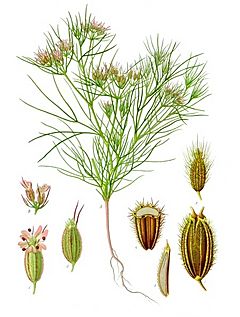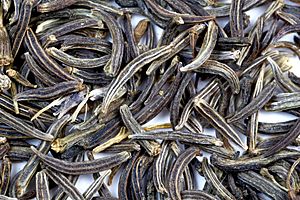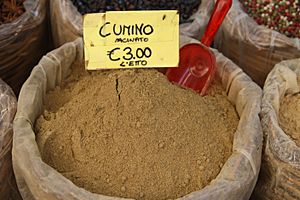Cumin facts for kids
Quick facts for kids Cumin |
|
|---|---|
 |
|
| Scientific classification | |
| Kingdom: | |
| Division: | |
| Class: | |
| Order: | |
| Family: | |
| Genus: |
Cuminum
|
| Species: |
C. cyminum
|
| Binomial name | |
| Cuminum cyminum |
|
Cumin (pronounced KYOO-min), also known as zeera, is a special flowering plant. It belongs to the Apiaceae family, which also includes parsley and carrots. Cumin originally grew in places from the east Mediterranean all the way to India.
People use the dried seeds of the cumin plant in many different ways. They are a popular spice in cooking around the world. You can find them used whole or ground into a powder. Cumin is also known for its traditional medicinal uses. For example, it has been used to help with digestion and even to treat problems like anemia or the common cold.
Contents
What is Cumin?
Cumin comes from the dried seeds of the Cuminum cyminum plant. This plant is part of the parsley family. The cumin plant grows to be about 30 to 50 centimeters (12 to 20 inches) tall. It is an annual plant, meaning it grows, produces seeds, and dies within one year.
The plant has a thin, branched stem that is usually grey or dark green. Cumin seeds look a bit like caraway seeds. They are oblong (oval-shaped) and have a yellow-brown color. Other plants in the same family, like parsley and dill, have similar looking seeds.
Cumin has a very unique and strong flavor and a warm smell. This comes from the special oils found inside its seeds.
A Look Back in Time: Cumin's History
Cumin has been used by people for a very long time. Scientists have found cumin seeds in India that are thousands of years old! It was also used in ancient Egypt. The Egyptians used cumin as a spice for food. They even used it to help preserve bodies during mummification.
Cumin first grew in Iran and around the Mediterranean Sea. It is mentioned in the Bible, both in the Old Testament and the New Testament. In ancient Greece, people would keep cumin on their dining tables, just like we keep pepper today. This tradition still happens in Morocco. The ancient Romans also used a lot of cumin in their cooking.
In India, cumin has been a key ingredient for thousands of years. It is used in many traditional dishes like kormas and masalas. It forms the base for many other spice mixes.
When Spanish and Portuguese explorers came to the Americas, they brought cumin with them. Today, cumin is grown in many countries. The main places are China, Uzbekistan, Tajikistan, Iran, Turkey, Morocco, Egypt, Syria, Mexico, Chile, and India.
Where Cumin Grows Today
India is the biggest producer and user of cumin in the world. It grows about 70% of all the cumin. India also uses most of the cumin it produces. Other countries that grow a lot of cumin include Syria, Turkey, and Iran. About 300,000 tons of cumin are grown around the world each year.
Cumin plants like warm weather and can handle dry conditions. They grow best in tropical or semi-tropical areas. The plant grows quite quickly, taking about 100 to 120 days to be ready for harvest.
How We Use Cumin
Cumin seeds are a very popular spice because of their unique taste and smell. They are used all over the world, especially in foods from South Asia, North Africa, and Latin America.
You might find cumin in some types of cheese, like Leyden cheese, and in traditional breads from France. It's also a common ingredient in Brazilian cooking. Cumin is often a main part of chili powder, especially in Mexican-style dishes.
Cumin can be used as whole seeds or ground into a powder. It adds a warm, earthy flavor to food. This makes it a key ingredient in many stews, soups, and spiced gravies. It is also used in some pickles and pastries.
Cumin for Health
In an ancient Indian health system called Ayurveda, dried cumin seeds are used for their health benefits. In Sanskrit, the old language of India, cumin is called Jira, which means "that which helps digestion."
People use powdered cumin seeds in different ways, like in special drinks or pills. It is believed to help with:
- Improving appetite
- Making food taste better
- Helping with digestion
- Improving eyesight
- Giving strength
- Helping mothers produce milk
Cumin is also used in traditional medicine to help with fevers, loss of appetite, diarrhea, and other stomach problems.
In southern India, people make a popular drink called "jira water" by boiling cumin seeds. They believe this drink is good for heart health, swelling, and poor digestion. While cumin seeds do have some iron, you would need to eat a lot of them to get a significant amount of iron from your diet.
Images for kids
-
Jeera (cumin) rice, a popular Indian dish.
See also
 In Spanish: Comino para niños
In Spanish: Comino para niños









